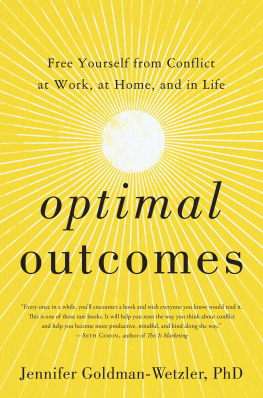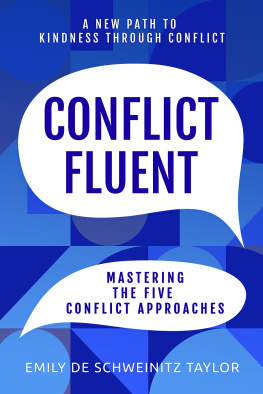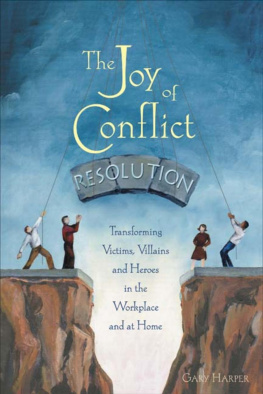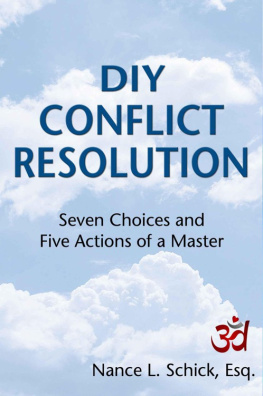Contents
Guide
For my family
Contents
I had been teaching executive leaders and graduate students to free themselves from recurring conflict for years before I decided to take on one of the persistent challenges in my adult life.
I love my mother dearly. She is my rock, my biggest supporter, and often the first person I go to for counsel. Still, a few years ago, a long-simmering conflict between us exploded. Im embarrassed now to admit it, but I gave her the classic shape up or ship out ultimatum, delivered via the central medium of our conflict: the cell phone. From my home office, I screamed at her, flung down the phone, and burst into tears. Twenty miles away in her apartment in the Bronx, my mom stewed in her own fury.
My threat was made in the heat of anger, and I later retracted it, after a week spent feeling angry, guilty, and unable to focus on anything else.
What got me so upset? My mom called me on the phone. If that sounds harmless, allow me to explain.
As with most working parents, each day is a delicate Rube Goldberg machine of moving parts; if I shift my attention away, missing one of the steps of the sequence, the ball drops and the game is over. At least it seems that way.
When my mother called me, often in the middle of the days hectic marchwhich is to say, between 6:00 a.m. and 9:00 p.m.I often responded with a huffy Im sorry, Mom, I dont have much time to talk right now.
My mother did not like that answer. But you never call me! How can you not have time for your mother? shed ask. Often, complaining about my not calling was the singular purpose of her call.
That happened again and again. At some point, I stopped answering most of her calls. That made her even more critical and carping about a wider range of things, which made me even more combative.
As often happens, one fight led to another and the conflict became harder and harder for my mother and me to escape. And each time a flare-up occurred, our relationship was diminished, bit by bit. This was almost inevitable.
The day I committed to breaking free from our conflict loop, I didnt make the commitment in private. I did it standing before a seminar of twenty graduate students and four teaching assistants in my class on Optimal Outcomes at Columbia University. I hoped using this real, raw episode in my life would help my students see that the practices Id be presenting over the course of the three-day workshop could successfully be applied to any conflict, no matter how close or seemingly cataclysmic. I also wanted them to understand that good things come from making yourself vulnerable.
But I was still nervous. I was opening myself up to a seminar full of graduate students, who at that point were still strangers to me. Would they think it was odd to dedicate class time to my mother and me? Would my being so personal alienate them?
I found out quickly that I had nothing to fear. As I described our conflict in more detailwhich Ill do for you, too, a bit laterI saw heads nodding and eyes sparkling with engagement.
Of course they got it. Aside from the fact that they had parental figures in their own lives, they also had conflicts so potent, so frustrating, that they had gone to tough places, too.
Me, you, and everyone: we all deal with conflict all the time. It doesnt matter how much we love our family, respect our colleagues, or like our neighbors. Conflict happens.
You do your best to manage it well, of course. Sometimes your efforts pay off. Other times, no matter what you do, the same problem keeps coming back again and again and again despite your best attempts to resolve it.
Like me, you feel stuck. Youve tried everything.
And youre at a complete loss for what to do next.
Thats where I was the day I let my students into my story. Being stuck in conflict was taking time and energy that I wanted to spend in an affirming way with the people I cared about, including my mother. Instead, everywhere I went I was thinking about the situation: while brushing my teeth, commuting, putting my kids to sleep, listening to people who had come to me for counsel. I was even dreaming about it.
Lets face it: being stuck in conflict can make it difficult to be present with what youre doing and contribute the way youd like to the people and world around you.
If any of this sounds familiar, the first thing I want you to understand is that youre not alone. Getting stuck in conflict is prevalenteven among the most seasoned leaders in business, academia, and government, some of whom Ive consulted with and whose stories I share throughout this book.
I have changed identifying details such as names and industries to protect my clients and students privacy. However, each of these stories reflects my experience working with leaders on some of the toughest problems theyve faced in their professional and personal lives.
How I Got Here
In my work as an organizational psychologist at the company I founded, Alignment Strategies Group, Ive used the Optimal Outcomes Method over the past thirteen years to help turn around challenging situations facing executives at some of the worlds leading organizations, universities, and public institutions. As a professor, Ive spent more than a decade teaching the Optimal Outcomes Method to midcareer professionals and students who come to Columbia Universitys Morton Deutsch International Center for Cooperation and Conflict Resolution from an array of Columbias graduate schools: business, international affairs, psychology, education, religion, and law. At the end of the three-day workshop, people who entered the room grappling with daunting conflicts leave revitalized with fresh perspective and a new sense of freedom.
I have written this book with the hopes that it will bring that sense of freedom to you as well.
The Optimal Outcomes Method reaches beyond what you may have encountered if youve read books on conflict resolution in the past. In my early career, I served as a facilitator at Harvard Law Schools Program on Negotiation (PON), the worlds most respected resource on dispute resolution and negotiation. That put me into the classrooms and conference rooms of two men who today remain giants in the field: the late Roger Fisher (who coauthored the seminal Getting to Yes: Negotiating Agreement Without Giving In in 1981) and Bruce Patton (a coauthor of Getting to Yes and also of the 1999 game changer Difficult Conversations: How to Discuss What Matters Most, whose firm I joined around the time the latter book was published). I had worked hard to get there, and it was an exciting, dynamic time, as Fisher and those he influenced moved the field away from competitive, winner-take-all-style negotiation to the collaborative, we-all-can-win approach that thankfully persists today.
It was a formative experience for me, yet as the years passed, I found myself asking questions that werent adequately addressed by the methods I was teaching. My academic background was in social psychology, but surrounded by lawyers, I began to notice that my colleagues saw conflict and its resolution as infinitely possible but tangible and finite. Every case had an end. Yet when I looked around at my own life and at the worlds most destructive struggles, I saw conflicts that seemed intractable, often resurfacing most violently just when resolution seemed near. For example, after several hopeful years of negotiations facilitated by a team of international diplomats who had been trained in win-win methods, the Oslo peace process between Israelis and Palestinians broke down and renewed cycles of violence took its place.
I wondered whether there was any hope for people who couldnt seem to negotiate their way to resolution through the win-win methods I had been advancing.
Next page






